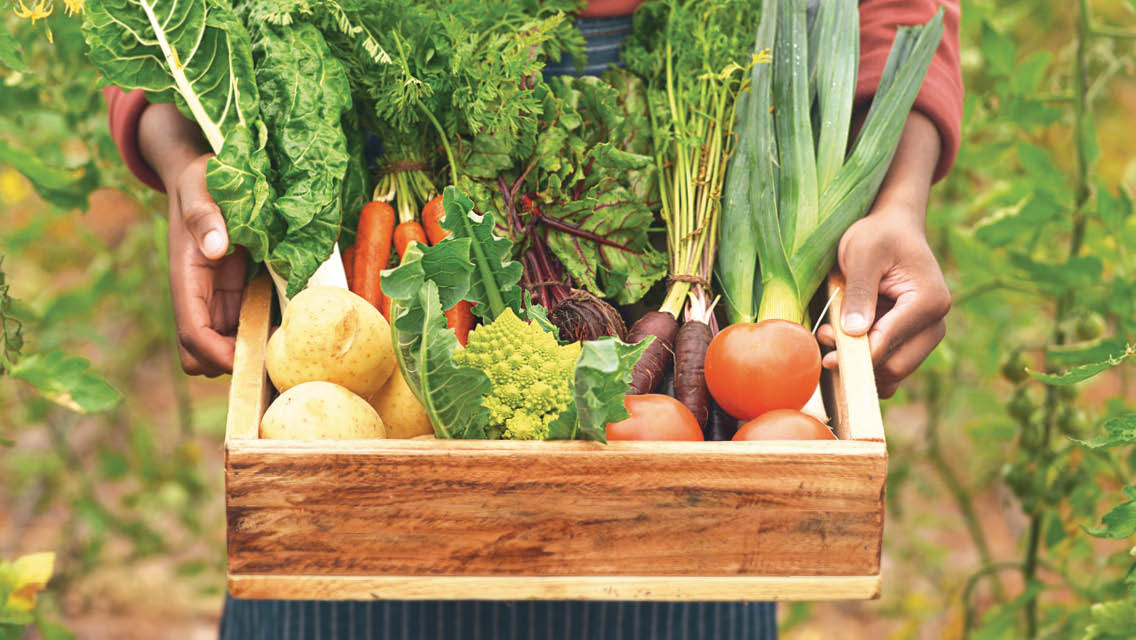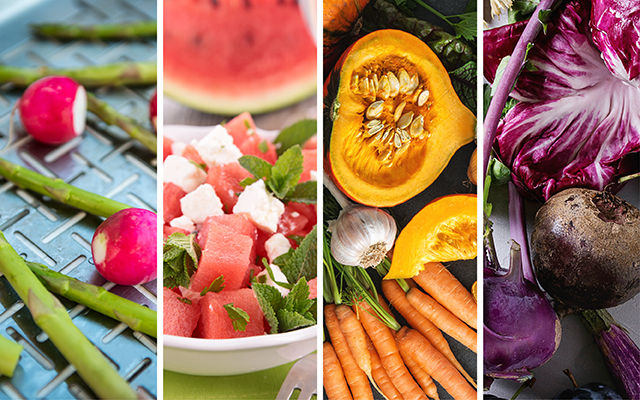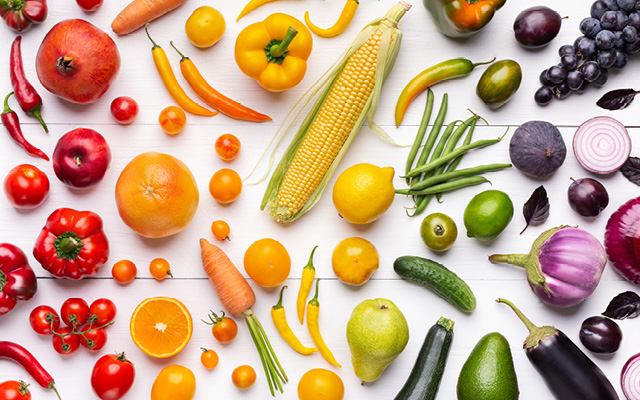There’s nothing like that first bite of a summer peach or the tang of fire-roasted chilies in autumn. If you enjoy fresh flavor and abundant produce but lack the space or time to grow your own, you might consider bringing those things to your table by investing in community supported agriculture (CSA).
CSA is a collective venture between consumers and an area farmer. Early each year, before the growing season begins, a grower offers CSA “shares” (memberships or subscriptions) of their crops to the public. You typically pay an upfront sum, often between $400 and $600 for a 20-week season, though many farms offer a half-season subscription or other payment options.
In return, you receive a weekly basket or box of seasonal produce. Some farms offer “protein shares” of eggs, cheese, or meat for an additional cost. Many offer even more options, such as maple syrup or fresh flowers. And most will allow you to include a list of undesirables: If you’re allergic to strawberries or you loathe green beans, your weekly box will not include them.
To find a CSA in your area, check LocalHarvest.org, a nationwide online database of farms, CSAs, and farmers’ markets. The site offers tips for choosing a share, including questions to ask farmers before you sign up.
Want to join this food movement? Read on to learn how you and your community could reap the rewards.
1. Support your food community.
With the rise in droughts, floods, and other effects of climate change, farming is becoming more financially risky — but CSA subscribers provide a safety net.
“Small-scale farming is in jeopardy,” says Jerusha Klemperer, director of FoodPrint, a website that helps people work toward a more sustainable, healthy food system. Klemperer explains that farmers often shoulder huge expenses, including farm-equipment repairs, mortgage payments, seedlings, and soil inputs that help crops grow — and typically, those expenses get recouped only postharvest.
“CSA dollars paid upfront go directly to farmers, who need money early in the growing season, long before they see harvest profits,” she adds.
In more than 10 years of CSA membership, Klemperer has never been disappointed. “If one crop fails, the farmers usually give me double of another vegetable,” she says.
CSA programs often have designated pickup sites at parks or in church or community-center parking lots. Members trade produce and receive recipes, which they may need for cooking or canning bumper crops of cucumbers or apricots.
When you invest in a local farm, you become part of something larger than yourself. Unlike most supermarkets, CSA is central to a close-knit food community.
“My customers are like family,” says Donal Yasukochi, owner of Yasukochi Family Farms near San Diego. “Some have participated in our CSA and farmers’ markets for 30 years. If someone can’t afford their CSA box one week, I tell them, ‘Pay us next time. We’re doing fine.’”
That sense of community is a vital, if intangible, benefit of these programs, notes Angel Dobrow, a longtime account manager for LocalHarvest’s software, CSAware. “Trust that local farmers have your interests at heart,” she says. “They’re growing for their community and for people they know and care about.”
You may feel a sense of pride and abundance simply from being more involved in the local food community, says Thomas Swendson, founder and president of New Mexico Harvest, a year-round, multifarm CSA project that includes 90 food producers throughout the state. “CSAs prove local food is exciting and interactive. We’re creating a large, intricate food community that pushes local into the spotlight.”
2. Get more fresh produce.
Local farm workers often harvest CSA produce no more than one day before members pick up their boxes. The journey from field to grocery store, on the other hand, can take much longer. Vegetables and fruit may sit in a truck for days before they’re unloaded and transferred to a storeroom, where they might sit for another day before arriving in the produce aisle.
Although these items are still safe and edible, shorter time between harvesting and eating a food means better nutritional benefits, says Klemperer. (For more on how the life cycle of your produce affects its flavor and nutrition, see “The Secret Lives of Fruits & Veggies“.)
CSA shares also provide dietary diversity, which is important for delivering the full spectrum of vitamins, minerals, and phytonutrients a body needs for good health. And you’re likely to encounter foods in your box that you’ve never tried before. Not sure what to do with that kohlrabi? Don’t panic: Farmers routinely provide recipes with the weekly shares, so you’ll get some tips for prepping unfamiliar items.
“Getting a parsnip in your bag might push your comfort zone, but if you try it, you’ll probably like it,” says Swendson. “You might even discover a new favorite flavor.”
3. Grow your local economy.
In the midst of economic downturns, supply shortages, and global shipping delays, it’s critical to protect local economies. CSA memberships can help do just that.
“If you can purchase food locally, you absolutely should,” says Dobrow. “By supporting small, entrepreneurial farmers, your dollars stay local.”
She believes CSA programs act as a stabilizing economic force in communities. They’re the antithesis of industrial food operations (“factory” farms), which produce cheap, low-quality food while often ignoring the welfare of their workers and animals. (For more on the human and environmental costs of large-scale industrial agriculture, see “The CAFO Conundrum“.)
Industrial crop production also creates imbalanced markets that damage small, rural businesses, according to FoodPrint. This has led to widespread economic decline in rural areas, because these large-scale models typically extract more than they return to the community. Instead, CSA and farmers’ markets are a sign that a town or city is thriving.
4. Shrink your environmental footprint.
CSA programs get a green thumbs-up for minimizing plastic and packaging waste, pesticide use, and long-distance transportation. Instead of supermarket salad greens encased in plastic boxes, you’ll receive veggies and fruits in cardboard boxes, paper bags, and baskets that you’ll return or reuse each week.
In addition, CSA farms are conscientious land stewards. “Statistically, small farms use fewer pesticides and chemical fertilizers than large, industrial-scale farms,” says Klemperer.
Because your CSA items are sourced locally, it also means fewer fossil fuels are burned to transport them to your doorstep. But Klemperer cautions that calculating “food miles” isn’t always as straightforward as we might think. For instance, local apples kept in electrically powered cold storage for nine months may require an amount of energy similar to that of newly harvested apples shipped to your grocery store from hundreds of miles away.
This speaks to another tenet of CSA programs: To everything, there is a season.
5. Eat according to the seasons.
Shifting to a more seasonal diet allows you to appreciate foods that are naturally available only at certain times of the year. “Grocery stores have created a false Eden, where we can eat what we want, whenever we want,” says Dobrow. “That’s not sustainable. Humans were meant to eat foods in season and when they’re ripe.”
A CSA membership allows you to attune to seasonal cycles: how peaches and plums are juiciest in summer, how delicious apples and pears taste in autumn. “Save nonlocal or tropical foods for special treats,” Dobrow suggests. “Grapefruit doesn’t grow in northern Minnesota where I live, so I eat it only a few times a year.”
At the grocery store, we often assume that we can get whatever produce we want, no matter the season. “The producers in our network educate members about the local and seasonal produce available in our state, which helps them understand why some staples aren’t always available from a CSA,” Swendson explains. “In New Mexico, onions and garlic are around most of the year, but popular avocados aren’t grown here.”
That’s part of the learning curve. “There’s a CSA mindset and lifestyle that go with a vegetable-heavy, seasonal diet: It involves cooking as much fresh food as you can,” he adds. “When the CSA provides lots of produce at one time, the solution is to can or preserve it — so you can enjoy it in the off season.” (For some beginner canning recipes, visit “How to Can Fruits and Vegetables“.)
This article originally appeared as “Why CSA” in the May 2022 issue of Experience Life.





This Post Has 0 Comments